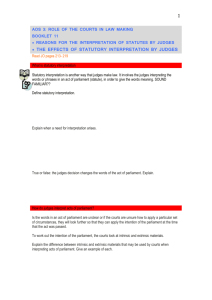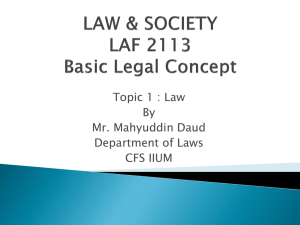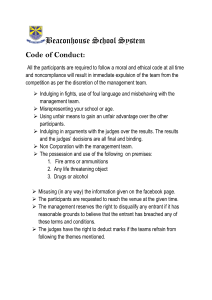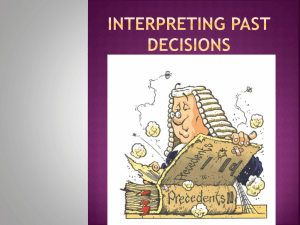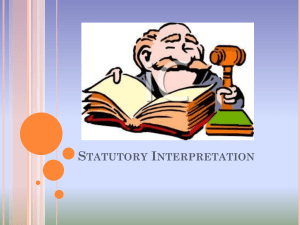Judicial creativity notes
advertisement
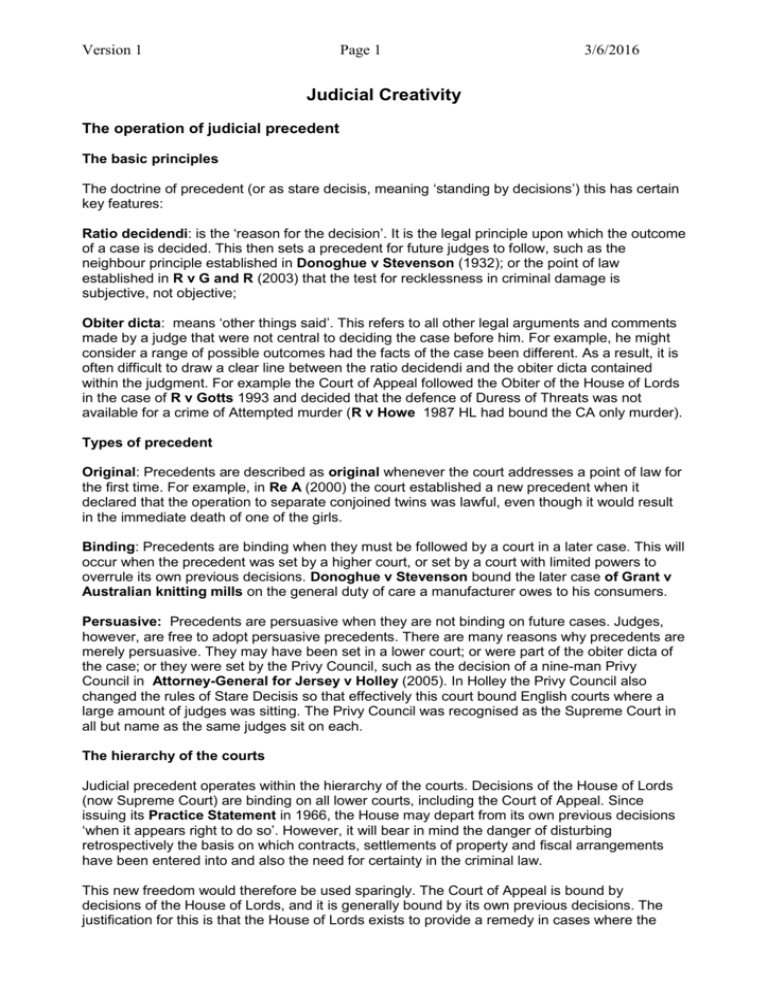
Version 1 Page 1 3/6/2016 Judicial Creativity The operation of judicial precedent The basic principles The doctrine of precedent (or as stare decisis, meaning ‘standing by decisions’) this has certain key features: Ratio decidendi: is the ‘reason for the decision’. It is the legal principle upon which the outcome of a case is decided. This then sets a precedent for future judges to follow, such as the neighbour principle established in Donoghue v Stevenson (1932); or the point of law established in R v G and R (2003) that the test for recklessness in criminal damage is subjective, not objective; Obiter dicta: means ‘other things said’. This refers to all other legal arguments and comments made by a judge that were not central to deciding the case before him. For example, he might consider a range of possible outcomes had the facts of the case been different. As a result, it is often difficult to draw a clear line between the ratio decidendi and the obiter dicta contained within the judgment. For example the Court of Appeal followed the Obiter of the House of Lords in the case of R v Gotts 1993 and decided that the defence of Duress of Threats was not available for a crime of Attempted murder (R v Howe 1987 HL had bound the CA only murder). Types of precedent Original: Precedents are described as original whenever the court addresses a point of law for the first time. For example, in Re A (2000) the court established a new precedent when it declared that the operation to separate conjoined twins was lawful, even though it would result in the immediate death of one of the girls. Binding: Precedents are binding when they must be followed by a court in a later case. This will occur when the precedent was set by a higher court, or set by a court with limited powers to overrule its own previous decisions. Donoghue v Stevenson bound the later case of Grant v Australian knitting mills on the general duty of care a manufacturer owes to his consumers. Persuasive: Precedents are persuasive when they are not binding on future cases. Judges, however, are free to adopt persuasive precedents. There are many reasons why precedents are merely persuasive. They may have been set in a lower court; or were part of the obiter dicta of the case; or they were set by the Privy Council, such as the decision of a nine-man Privy Council in Attorney-General for Jersey v Holley (2005). In Holley the Privy Council also changed the rules of Stare Decisis so that effectively this court bound English courts where a large amount of judges was sitting. The Privy Council was recognised as the Supreme Court in all but name as the same judges sit on each. The hierarchy of the courts Judicial precedent operates within the hierarchy of the courts. Decisions of the House of Lords (now Supreme Court) are binding on all lower courts, including the Court of Appeal. Since issuing its Practice Statement in 1966, the House may depart from its own previous decisions ‘when it appears right to do so’. However, it will bear in mind the danger of disturbing retrospectively the basis on which contracts, settlements of property and fiscal arrangements have been entered into and also the need for certainty in the criminal law. This new freedom would therefore be used sparingly. The Court of Appeal is bound by decisions of the House of Lords, and it is generally bound by its own previous decisions. The justification for this is that the House of Lords exists to provide a remedy in cases where the Version 1 Page 2 3/6/2016 Court of Appeal cannot. The Court of Appeal has limited powers to depart from its own previous decisions. Both divisions may take advantage of the three exceptions identified in Young v Bristol Aeroplane (1944), and the criminal division is free to depart from its own earlier decision in cases where the freedom of an individual is at stake, as in R v Gould (1968) CA. Law reporting Reports of the facts and judgments of cases are required for judicial precedent to operate successfully. Since 1865, law reports have been published under the auspices of the Incorporated Council of Law Reporting for England and Wales, which is a joint society of the Inns of Court, the Law Society and the Bar Council. In 1953, the Council began publishing the Weekly Law Reports, which are available either weekly or in annual bound volumes. The All England Reports are also published weekly, by LexisNexis Butterworths. Some newspapers publish summaries of important cases, and computerised law reporting systems are increasingly available. Means of avoiding precedent Distinguishing A precedent set in Case A should be followed in the later Case B where the facts of the two cases are similar. For example, a contract is not formed unless the two parties intended to enter into a legally binding agreement. Where an agreement is made in a domestic setting, such as a husband promising to buy his wife an eternity ring for their silver wedding, the courts presume that it was not intended to be legally binding. The key differences between Balfour & Merritt on a presumption of no legal relations in making a contract were distinguished. In Merritt v Merritt (1971), the husband and wife had separated before making their agreement, and secondly that their agreement had been written down and signed. These points allowed the court to distinguish the precedent set in Balfour v Balfour (1919). Theoretically, at least, the power to distinguish offers judges unlimited discretion to avoid existing precedents. Reversing Sometimes the higher court will decide that a lower court reached the wrong decision in a case. The higher court will then alter the decision made by the lower court. This is known as reversing the decision of the lower court. This famously occurred twice in R v Kingston (1994). The case concerned the defence of intoxication: Kingston, a known paedophile, was drugged by blackmailers and lured into abusing a 15-year-old boy. His conviction for indecent assault was overturned by the Court of Appeal on the grounds of involuntary intoxication. However, the House of Lords reinstated a guilty verdict: Kingston’s inhibitions had been severely impaired by the drugs he had involuntarily taken, but he was still capable of forming the mens rea of the offence. In the words of Mustill LJ: ‘mere disinhibition’ is insufficient to found a defence. Overruling In reversing, only one case is involved. In overruling, at least two cases are involved. In Case B, the court decides that the point of law decided previously in Case A was wrong and so changes it. In Addie v Dumbreck (1929) a four-year-old trespasser wandered onto the defendant’s land and was crushed in the wheel of a machine operated by a colliery. The colliers had ‘NoTrespassing’ signs in place, but were aware that these were regularly ignored by children. Nevertheless, the House of Lords decided that there was no general duty of care to trespassers. Forty years on, attitudes had changed. In British Railways Board v Herrington, the claimant was a six-year-old boy who suffered serious burns and injuries on an electrified railway line. He had stepped over a damaged fence running alongside the line. The House of Lords decided that, in the years since the decision in Addie v Dumbreck (1929), social and physical Version 1 Page 3 3/6/2016 conditions had changed dramatically: in particular the growth of towns had brought about a lack of play areas for children, leading to an increased temptation to trespass. In view of this, it would now be right for an occupier to owe a duty of care to trespassers. Creativity within statutory interpretation The basic principles The responsibility of Parliament for the legislative process has ended by the time that the Bill receives royal assent. Members of Parliament have no further influence over the Act. Under the doctrine of the separation of powers, it is the role of the judiciary to interpret and apply that legislation. To ensure that they manage this responsibility effectively, judges have developed a range of approaches. Although many of these approaches are called rules, they are not necessarily binding upon judges: discretion exists in the selection of approach to adopt, and the outcome of a case may depend entirely upon the approach selected. The literal rule Under this rule judges follow the literal meaning of the words used in the statute rather than seeking to discover the intention of Parliament behind the legislation. Lord Simonds argued that it is the duty of the court to interpret the words used and even if these words are ambiguous, judges should not go on a ‘voyage of discovery’ to find their intended meaning. In Whiteley v Chappell (1868) the defendant had voted twice in an election, first using his own name, and secondly masquerading as someone who had died. He was charged with impersonating a person entitled to vote in an election. Using the literal rule the court found him not guilty: he could not be guilty of impersonating someone entitled to vote, since dead people are not entitled to vote, meaning judges have no ability to be creative in developing the law for situations parliament did not envisage when creating the act. The golden rule The golden rule is used to mitigate the harshness of the literal rule. However, it is restricted to cases where the key word has more than one meaning. If one meaning would result in a ‘manifestly absurd’ outcome, another is to be preferred. Lord Reid once declared: ‘You may not for any reason attach to a statutory provision a meaning which the words of that statute cannot possibly bear. If they are capable of more than one meaning then you can choose between those two meanings, but beyond that you cannot go.’ This approach was adopted in Adler v George (1964). Under s3 of the Official Secrets Act 1920 it was an offence to be found ‘in the vicinity of a prohibited place’. The accused was arrested inside Marham Royal Air Force station, and argued that the phrase ‘in the vicinity of ’ implied being ‘outside of ’ a prohibited place. Lord Parker used the golden rule: ‘in the vicinity of ’ could mean ‘being in or in the vicinity of ’ the prohibited place. To have acquitted the defendant would have been a manifestly absurd outcome. The mischief rule A very different approach can be seen in the mischief rule. Here the courts identify the mischief or problem with the old common law, and then examine the remedy provided by Parliament. They then try to ensure that they give effect to this remedy. This approach was adopted in Smith v Hughes (1960). Under the Street Offences Act 1958 it was an offence for prostitutes to solicit in the street. In this case the prostitutes were soliciting men from the open window of a house. Using the mischief rule, the courts identified the problem with the old common law (harassment), and looked at how Parliament tried to overcome this (by preventing soliciting in Version 1 Page 4 3/6/2016 the street). They gave effect to this by finding the women guilty, even though they could have argued under the literal rule that they were not in the street at the time of the offence. The purposive approach This approach is becoming increasingly popular in UK courts. Here, judges examine not only the words used on the pages of the Act, but also the intention of Parliament when using these words. In the case of Jones v Tower Boot Company (1997) the claimant had suffered constant harassment by fellow workers at the Tower Boot Company. The Race Relations Act 1976stated: ‘Anything done by a person in the course of employment shall be treated for the purposes of this Act as done by his employer as well as by him, whether or not it was done with the employer ’s knowledge or approval.’ The employers argued that these activities were not authorised, and therefore not done ‘in the course of employment’. The Court of Appeal adopted a purposive approach: the purpose of the Race Relations Act 1976 was to prevent in the workplace the discriminatory conduct to which the victim had been subjected. Therefore the employers were liable. Creativity within the operation of statutory interpretation Approaches that restrict judicial creativity Disadv: The literal approach is inflexible. Consistency is of no use without justice and fairness. It is unreasonable to expect Parliamentary draftsmen to be able to anticipate every conceivable interpretation, and misinterpretation, of their words. It can defeat the legislative intention of Parliament. Clearly the defendant in Whiteley v Chappell (1868) was committing an offence but literal was not flexible enough to recognise this. . Adv: It promotes consistency and encourages Parliamentary draftsmen to be precise. Respects Parliamentary sovereignty as judges are unelected and shouldn’t change law made by elected MPS’. Approaches that promote judicial creativity The mischief rule and the purposive approach both require judges to examine the intention of Parliament when introducing the legislation. Adv: Enables judges to give effect to the declared intentions of Parliament. For example, in the case of Jones v Tower Boot Company Ltd (1997), if the Court of Appeal judges had adopted the literal approach Tower Boot Co may not have been liable for the racial abuse of employees on their premises. However, CA took a purposive view of in ‘course of employment’, looking at broad aim of Race relations Act which was designed to prevent racial harassment at work: this was better achieved by holding employers responsible for the actions of their employees. Where employers had taken reasonable steps to ensure that such harassment did not arise, a defence would be available to them. Where they had not, it would not be reasonable to excuse them. External aids It is necessary if judges are to give effect to the intentions of Parliament. Hansard is the record of Parliamentary debates, and since the decision of the House of Lords in Pepper v Hart (1993), judges are able to refer to the speech of the government minister proposing the Bill in Parliament. But there are limitations placed on Hansard use to stop cost and time wasting for very little benefit in interpreting the Act. Law Commission reports help judges to identify the thinking behind an Act. In R v G and R (2003), concerning whether the MR for Criminal Damage should be subjective rather than objective recklessness, Lord Bingham referred to the Law Commission report that lead to the introduction of the Criminal Damage Act.’ Lord Bingham was able to establish that the test for Version 1 Page 5 3/6/2016 recklessness at the time of the 1971 Act was presumed to be subjective. In this way he laid the foundation for overruling the decision in Caldwell, and reimposing a subjective test for recklessness in criminal damage. The creative role of judges The constitutional relationship between Parliament and the judiciary According to constitutional convention, Parliament is the supreme legislative authority in the United Kingdom, and no other body can challenge this position. The general rule that judges cannot overrule parliament The courts should not act in a way that frustrates the stated will of Parliament as stated in act. The case of Holley (2005) concerned the partial defence of provocation. Delivering the opinion of the majority, Lord Nicholls was critical of the approach of the House of Lords in Smith. The main target of his criticism was the attempt by the House of Lords to depart from the law as declared by Parliament in the Homicide Act 1957. In his words: ‘It is not open to judges to change the common law and thereby depart from the law as declared by Parliament.’ Underpinning this judgment is recognition by Lord Nicholls of the constitutional position of Parliament as the supreme legislative authority. Limited situations where judges overrule Parliament In recent years, however, Parliament has chosen to place some limits upon its own sovereign legislative authority, through membership of the European Union and through the passage of the Human Rights Act 1998. 1. European Union: Parliament has allowed EU law to overrule conflicting national law, as seen in the series of cases known as Factortame. The law lords declared part of the Merchant Shipping Act 1988 invalid as it conflicted with European Union law, demonstrating not only the overruling of national legislation to European law, but also, the ability of the judiciary to set aside the clearly expressed will of Parliament, which in this case was to stop foreign fishing vessels catch fish in UK waters. Clearly judges can create laws that go against the wishes of parliament in certain EU matters. 2. Human Rights Act 1998: Where judges rule that part of an Act of Parliament has breached one of the human rights contained within the European Convention on Human Rights as enshrined in the 1998 Act, they have the power to make a declaration of incompatibility. In A and Others v Secretary of State for the Home Department (2004). The House of Lords ruled that s23 of the Anti-Terrorism, Crime and Security Act 2001, in permitting the indefinite detention of foreign nationals without charge, was incompatible with article 5 of the European Convention of Human Rights. Parliament felt obliged to comply with this judgment, and so the Prevention of Terrorism Act 2005 was passed. In this type of situation not only are judges effectively creating laws in contravention of parliaments wishes but parliament are actually having to then create a law that satisfies judges, unelected judges dictating what an elected parliament should do. Version 1 Page 6 3/6/2016 Public policy issues These are any issues which the public, through elected MP’s consider very controversial and or important. For example The Civil Partnership Act 2004 and the Equality Act 2006 extended earlier provisions, demonstrating a new policy direction. According to convention, the judiciary leaves matters of policy to Parliament. Ronald Dworkin distinguishes between principles and policy. Principles are concerned with rights, and with standards of fairness and justice; people are equal before the law; defendants are presumed innocent until found guilty. These should always be applied by judges. Policies, on the other hand, are concerned with achieving social or political goals, such as the redistribution of wealth, or the protection of the environment. These, Dworkin argues, are the responsibility of the legislature rather than of the judiciary. He condemns judges who stray from principles into areas of policy. Statutory Interpretation Example of judges making Policy For example, the case of Royal College of Nursing v DHSS (1981) involved interpretation of the Abortion Act 1967. Under the Act, abortions had to be carried out by a ‘registered medical practitioner ’. Since 1967, various drugs have been developed making it possible for nurses to carry out this operation. In a dissenting judgment, two law lords argued that the matter should be left to Parliament since it would be a significant policy change to allow nurses to carry out abortions. Judicial Precedent example of judges making Policy In Shaw v DPP (1961) the House of Lords recognised the new offence of conspiracy to corrupt public morals. In the words of Viscount Simonds: ‘there remains in the courts a residual power to enforce the supreme and fundamental purpose of the law, to conserve not only the safety and order, but also the moral welfare of the State’. In his dissenting judgment, Lord Reid argued that Parliament is the proper place for deciding whether the law should intervene further in the enforcement of morality Judges also engage in policy considerations when examining human rights under the Human Rights Act 1998. In A and Others v Secretary of State for the Home Department (2004) the courts declared existing counter-terrorism legislation to be incompatible with rights contained within the European Convention on Human Rights, as enshrined in the 1998 Act. Although the decision of the courts was based upon established principles such as habeas corpus, it has continued to have a serious effect upon the implementation of government policy. See the current issues on the Justice and Security Bill and secret courts. In judicial review of the decisions of government ministers, judges inevitably have to consider matters of government policy. In Council of Civil Service Unions v Minister for the Civil Service (1984), (‘The GCHQ Case’) the House of Lords upheld, on the grounds of national security, the ban on trade union membership imposed upon employees of the government surveillance headquarters in Cheltenham by the prime minister. This decision was seen by many as pro-government and anti-trade union. However, it was based upon an interpretation of established law and not upon policy considerations. Version 1 Page 7 3/6/2016 Judicial attitudes Declaratory theory of Precedent Those who believe in this theory argue that the correct law is always in existence but it needs to be found (a bit like buried treasure). William Blackstone, the famous 18th century legal writer felt that judges simply declare the law as it is always in existence waiting to be found. A simple example would be the mistake made by the House of Lords in Anderton v Ryan over effectively ignoring the Criminal Attempts Act 1981. Anderton was charged with handling stolen property, a video recorder, but the prosecution had dropped the charge of theft of the same item. Effectively this made the video recorder for legal purposes property that wasn’t stolen so Anderton could not be found guilty of handling stolen property. However, the House of Lords ignored the Criminal Attempts Act which clearly stated even crimes attempted that were impossible would still be an offence as long as the D intended it. One year later the House of Lords overruled Anderton in the case of R v Shivpuri, where the D thought he was smuggling cocaine into the country where in fact it was vegetable powder. This time the House of Lords declared what the law was and applied it to the Shivpuri case, finding him guilty. Clearly the Criminal Attempts Act was in existence throughout both cases and finally the House of Lords discovered and declared what the law was. This was not creating new law but simply formally declaring what the law is. However, most judges do not believe that this approach can be adopted to any but unique situations. For example, where there is no parliamentary legislation on an issue such as the current super injuctions and the right to privacy, it is difficult to argue judges are simply declaring what the law already is. Judicial precedent is creating law Judges like Lord Reid believe they do make new laws: ‘We do not believe in fairy tales any more, so we must accept the fact that, for better or worse, judges do make law.’ However, he recognised the demarcation between the judiciary and Parliament. In Knuller v DPP (1973), another case concerned with the offence of conspiracy to corrupt public morals, he declared: ‘I said in Shaw’s case and I repeat that Parliament and Parliament alone is the proper authority to change the law with regard to the punishment of immoral acts. Rightly or wrongly the law was determined by the decision in Shaw’s case. Any alteration of the law as so determined must in my view be left to Parliament.’ Other judges have proved to be more ready to embrace a creative approach. Lord Denning was driven by the basic principle: ‘The judge should make the law correspond with the justice that the case requires.’ In Davis v Johnson (1979) he ignored a binding precedent set by the Court of Appeal only days earlier, and extended the protection available under the Domestic Violence and Matrimonial Proceedings Act 1976. In Magor and St Mellons (1950) Lord Denning expressed his criticism of the ‘ultra-legalistic’ interpretations that would deprive claimants of their rights. A cynic might conclude that this does more to give power to the judiciary than to carry out the intention of Parliament. Viscount Simonds described filling in the gaps as a ‘naked usurpation of the legislative function under the thin disguise of interpretation’. Version 1 Page 8 3/6/2016 Should judges make law? The benefits 1. There are clear benefits to be derived from an active judiciary. First, it provides flexibility. Appropriate precedents may be followed, and inappropriate ones may be distinguished or overruled. British Railways Board v Herrington (1972), and R v R (1991) demonstrates the willingness of the judiciary to adapt the law to changing social circumstances. AttorneyGeneral for Jersey v Holley (2005) shows its readiness to recognise past errors of judgment and amend the law accordingly. 2. Secondly, the judiciary is able to provide practical solutions to real-life situations. The decision of the House of Lords in R v R (1991) provided an instant solution to the problem of the law on marital rape that had been festering for many years. In the Court of Appeal hearing in Davis v Johnson (1979), Lord Denning pointed the way to providing a remedy for a cohabitee, as opposed to a married woman, suffering domestic violence at the hands of her partner. In Re S (2000) the courts were faced with an application to perform a caesarean section on an unwillingly mother in the sure knowledge that baby would immediately die. They were able to expand the law on parental consent issues based on persuasive precedents from other similar jurisdictions and decide the outcome within 1 hour. 3. Thirdly, judges are able to address problems created by advancements in technology. In Royal College of Nursing v DHSS (1981) the House of Lords, in the light of technical advancements in drug-induced abortions, had to address the interpretation of a section of the Abortion Act 1967, and the use of the term ‘medical practitioners’. In 2004, in the case of Natalie Evans, the Court of Appeal had to decide whether, under the terms of the Human Fertilisation and Embryology Act 1994, a young woman could have her frozen embryos implanted once her former boyfriend had withdrawn his consent. 4. Fourthly, judges are able to devote the required time to due consideration of a case. This contrasts with Parliament, which may see the need for legislation in a particular field, but not be able to prioritise it because of competing interests. For example, the need for wholesale reform of the law on non-fatal offences has been recognised for many years, with reports and draft bills being produced. However, Parliament has failed to provide the necessary time to introduce legislation. During the same period of time the courts have been active in developing the law. In R v Savage (1992), the House of Lords overruled Spratt (1990) and reversed Parmenter (1991) in declaring that the mens rea for s47 occasioning actual bodily harm does not require intention or recklessness as to the harm caused. In Chan-Fook (1994) the Court of Appeal declared that actual bodily harm includes psychiatric injury, and in DPP v Smith (2005) it was decided that cutting off a significant part of a person’s hair satisfies the actus reus of actual bodily harm. The problems 1. First, judges are not elected. Nor are they representative of society as a whole in terms of gender, ethnic origin, social class or age. In May 2006, Lord Falconer, the Constitutional Affairs Secretary and Lord Chancellor, issued a ministerial statement giving details of a strategy to increase the diversity of the judiciary. This was to include widening the range of people eligible to apply for judicial office, encouraging a wider range of applicants, and promoting an open and fair selection process. Meanwhile, the senior ranks of the judiciary remain predominantly white, middle-aged and male, promoting a suspicion, whether wellfounded or not, that the judiciary lacks understanding and accountability. Version 1 Page 9 3/6/2016 2. Secondly, laws made by Parliament generally apply to the future whereas technically precedents made by judges have retrospective effect. Acts come into force either at midnight on the day they receive royal assent, or at some time in the future specified in the Act. For example, the Human Rights Act was passed in 1998, but came into force on 1 October 2000. 3. As precedent as retrospective effect this makes a person a criminal for an offence that, arguably, did not exist at the time it was committed. For example, in R v R (1991) the bar on marital rape was removed. However, the offence was committed before this bar was removed, when the old law still applied. The European Court of Human Rights has ruled that this does not contravene Article 7 of the European Convention on Human Rights, which states that no one should be found guilty of an offence which was not an offence when it was committed. Retrospective law prevents the law being used as a guide to future conduct, and therefore breaches one of the eight principles identified by Lon Fuller as essential for a valid legal system. 4. Thirdly, judge-made law can only be made when cases come to court. Therefore it is patchy, random, unstructured, and dependent upon the willingness and ability of the parties to pursue the matter on appeal. The law on involuntary manslaughter is a prime example of judicial ping-pong, with subjective recklessness and gross negligence apparently striving for supremacy in those cases which are not suitable for unlawful act manslaughter. The elements of gross negligence manslaughter continue to attract debate, and the existence of subjective recklessness manslaughter is still questioned 5. Finally, judges are often pressurised into making hasty decisions. In Re S (1996) an application to force a heavily pregnant woman to undergo a Caesarean section operation against her wishes was heard by the court within hours of its receipt, and the application granted. Later, at leisure, the Court of Appeal was able to give due consideration to the principles involved, and ruled that the woman’s rights were paramount: the fact that her decision seemed unreasonable or bizarre was of no relevance. However, the Court of Appeal ruling was too late for the outcome to be changed. Version 1 Page 10 3/6/2016 Activity One Which is the odd one out and why? What links the others? Fisher v Bell Ejusdem Generis Dictionaries Whiteley v Chappell Express Wording Human Rights Act Smith v Hughes Per incuriam Hansard LNER v Berrimen Noscitur a sociis Explanatory Notes Version 1 Page 11 3/6/2016 Activity Two Match the spaces with the missing words on the Human Rights Act expression open family imprisonment liberty speech discrimination Article 2 Article 3 Article 4 Article 5 Article 6 Article 7 Article 8 Article 9 Article 10 Article 11 Article 12 Article 13 omission fair remedy prisons social liberty religion life slavery assembly politics trade union Everyone’s right to _______ shall be protected by law. No one shall be deprived of his life intentionally save in the execution of a sentence of a court. No one shall be subjected to torture or to inhuman or degrading treatment or punishment. No one shall be held in ____________ or servitude. Everyone has the right to ___________ and security of person. In the determination of his civil rights and obligations or of any criminal charge against him, everyone is entitled to a _______ and public hearing within a reasonable time by an independent and impartial tribunal established by law. No one shall be held guilty of any criminal offence on account of any act or _________ which did not constitute a criminal offence at the time when it was committed. Everyone has the right to respect for his or her private and _________ life, his home and his correspondence. Everyone has the right to freedom of thought, conscience and ___________. Everyone has the right to freedom of _______________. Everyone has the right to freedom of peaceful _____________ and to freedom of association with others, including the right to form and to join a_____________ ___________ for the protection of his interests. Men and women of marriageable age have the right to marry and to found a family. Everyone whose rights and freedoms as set forth in this Convention are violated shall have an effective ___________ before a national authority. Version 1 Page 12 3/6/2016 Answers – Human Rights Article 2 Article 3 Article 4 Article 5 Article 6 Article 7 Article 8 Article 9 Article 10 Article 11 Article 12 Article 13 Everyone’s right to LIFE shall be protected by law. No one shall be deprived of his life intentionally save in the execution of a sentence of a court. No one shall be subjected to torture or to inhuman or degrading treatment or punishment. No one shall be held in SLAVERY or servitude. Everyone has the right to LIBERTY and security of person. In the determination of his civil rights and obligations or of any criminal charge against him, everyone is entitled to a FAIR and public hearing within a reasonable time by an independent and impartial tribunal established by law. No one shall be held guilty of any criminal offence on account of any act or OMISSION, which did not constitute a criminal offence at the time when it was committed. Everyone has the right to respect for his or her private and FAMILY life, his home and his correspondence. Everyone has the right to freedom of thought, conscience and RELIGION. Everyone has the right to freedom of EXPRESSION. Everyone has the right to freedom of peaceful ASSEMBLY and to freedom of association with others, including the right to form and to join a TRADE UNION for the protection of his interests. Men and women of marriageable age have the right to marry and to found a family. Everyone whose rights and freedoms as set forth in this Convention are violated shall have an effective REMEDY before a national authority. Version 1 Retrospective law-making: all judge-made law is necessarily retrospective; statute law is only occasionally retrospective; the War Crimes Act 1991 is such an Example Karl Llewellyn (1893–1962): an American legal scholar, Llewellyn argued that judges are influenced by a range of factors that are unrelated to the law; he was therefore critical of those who viewed the law as something that operated simply as a system of objective rules. American Legal Realism: legal realists believe that the outcome of cases is decided not by the law in the textbooks but by other factors. Jerome Frank once declared that a case might be decided by what the judge had for breakfast Ronald Dworkin: an American legal philosopher who was, until 2008, a professor of Jurisprudence at UCL; he argues that judges should apply legal principles, and leave matters of policy to the legislature. Royal College of Nursing v DHSS (1981): a wide interpretation of the words used in an Act may be applied by the courts in order to give effect to the remedy devised by Parliament. Shaw v DPP (1961): under common law, the courts retain a residual power to develop new offences. Ashton v Turner (1980): where two parties are engaged in criminal activity, the law will not allow the first party to claim damages for harm suffered due to the negligence of the other party. The GCHQ Case (1984); DPP v Hutchinson (1990): this combination of cases may be used to illustrate that the courts decide Page 13 3/6/2016 Version 1 Page 14 matters concerning public policy in an impartial manner, without due deference to the government of the day Human Fertilisation and Embryology Act 1994: as this Act (now amended) struggles to keep pace with developments in medical science, judges are forced to confront difficult ethical issues R v R (1991): abandoned the long-held rule that a man cannot be guilty of raping his wife. R v Savage: the facts of this well-known case are as follows; while throwing some beer over another woman, the glass slipped out of her hand and broke; some shards of glass cut her victim’s wrist. Jackson v Horizon Holidays Ltd (1975): a remedy was provided to a claimant and to his family when their holiday had failed to live up to its advertised description, even though the claimant was the only member of his family to have contracted with the travel agent. Re S (1996): a declaration of the law by a higher court may arrive too late to prevent an injustice occurring. A and Others v Secretary of State for the Home Department (2004): the courts may rule statutes to be incompatible with human rights legislation. Relationship between Parliament and the Judiciary: according to the unwritten constitution, Parliament is responsible for making law, and judges for interpreting and applying law. 3/6/2016
